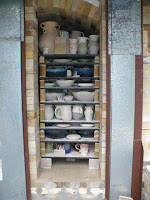




Here are photos of some of the pots from the first firing of my new kiln.
Fueled by propane, most of the glazes appear much different than from my old kiln.
One reason would be the reduction atmosphere was greatly increased. While back-pressure could be observed from the top & middle peep holes during the firing, how much reduction is only relative to previous observations.
The set of nested bowls in the last pic is a good example: The glaze inside the bowls has 3% copper that usually comes out of a fire appearing celadon-colored, sometimes splashed red or violet. This time it came out blue. I'm not complaining at all, but I was very surprised.
The bowl directly above it was a re-fire, of a black & white bowl that was not interesting at all. In the increased reduction atmosphere, the colors have flowed & copper migrated into a beautiful result. (In my opinion.)
There was only one bowl whose glaze ran onto a shelf. Although there were a number of pots that were under-fired, they can be re-fired a later time. It was strange to see pots with under-fired glaze on the same shelf as those with mature glazes - even the same glaze.
Howard & I had much discussion as each shelf was unloaded. His opinion of the result & my observation of what I expected. We made significant change to the design of the bag wall.
The next firing will be mostly wood-fueled, and with the bag wall change, should result in a much more even firing.
This firing had to go slow to dry out the mortar & bricks, check the bag wall design, and check for any major air leaks. I am very pleased with the results and the kiln.
I look forward to the next firing - the first wood-fueled firing of my new kiln.
There is much wood-splitting & stacking to be done. I absolutely have to get a handle on how much wood it will take to fire this kiln. Stay tuned....










